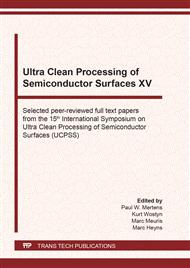p.60
p.66
p.71
p.79
p.84
p.89
p.95
p.101
p.107
Analysis of Surface Reaction for Group III-V Compound Semiconductors in Functional Water
Abstract:
Group III–V compound semiconductors are attracting attention as new channel materials that have higher carrier mobility than Si. However, defects easily occur at the interface between the semiconductor and insulator film, which degrades performance. In an earlier study, we demonstrated that the interfacial properties of InP are degraded by the growth of In2O3 and that In2O3 grows better in water than in air. Therefore, it is necessary to suppress the growth of In2O3 to improve the interfacial properties of InP. In this work, we focused on functional water, which can be controlled by adjusting the water conditions, and investigated the growth behavior of In2O3 in functional water. As a result, we found that the growth is suppressed in the low-pH range and in hydrogen water. It is important that H+ ions reduce OH− ions, which contributes to the reaction with InP.
Info:
Periodical:
Pages:
84-88
Citation:
Online since:
February 2021
Keywords:
Price:
Сopyright:
© 2021 Trans Tech Publications Ltd. All Rights Reserved
Share:
Citation:


